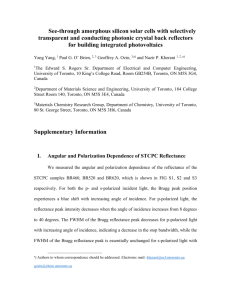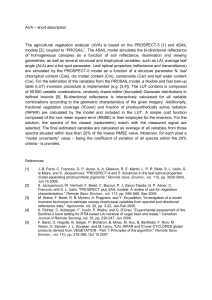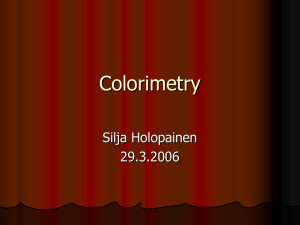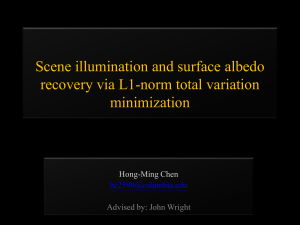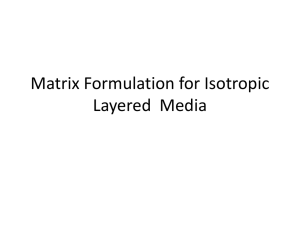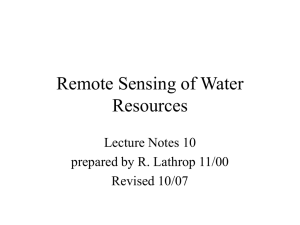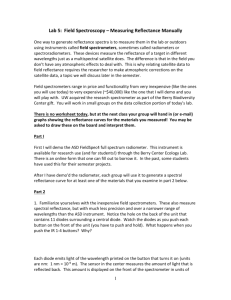Flexible multilayer metasurface(JAP)_sup_072913
advertisement
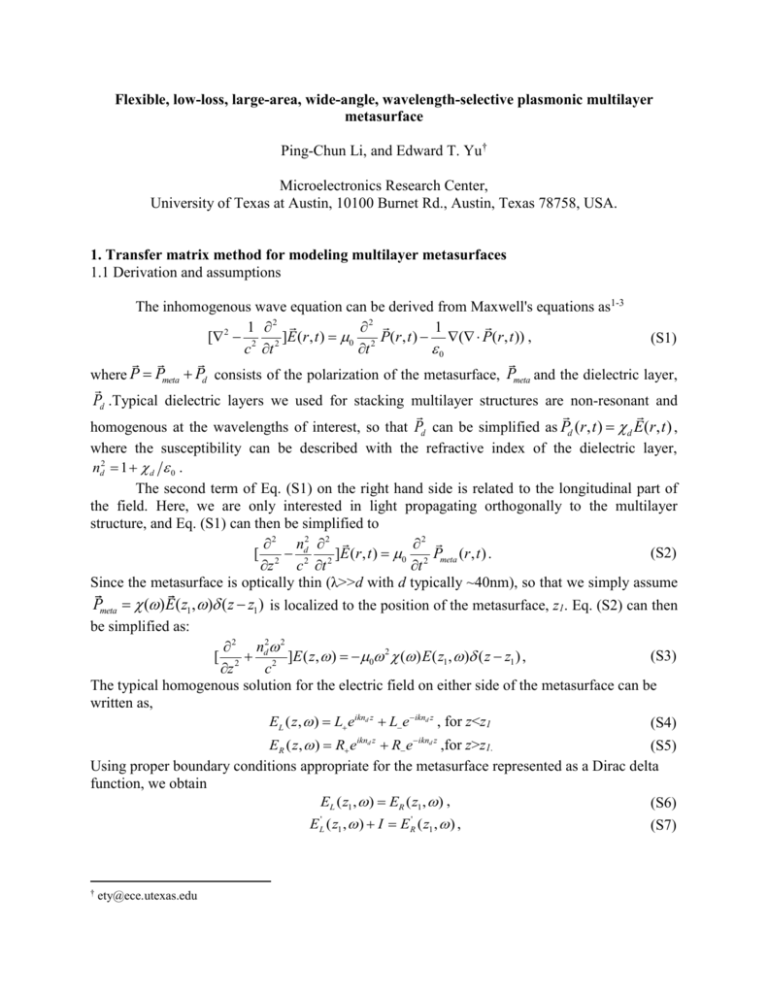
Flexible, low-loss, large-area, wide-angle, wavelength-selective plasmonic multilayer metasurface Ping-Chun Li, and Edward T. Yu† Microelectronics Research Center, University of Texas at Austin, 10100 Burnet Rd., Austin, Texas 78758, USA. 1. Transfer matrix method for modeling multilayer metasurfaces 1.1 Derivation and assumptions The inhomogenous wave equation can be derived from Maxwell's equations as1-3 1 2 2 1 2 [ 2 2 ]E (r , t ) 0 2 P(r , t ) ( P(r , t )) , c t t 0 (S1) where P Pmeta Pd consists of the polarization of the metasurface, Pmeta and the dielectric layer, Pd .Typical dielectric layers we used for stacking multilayer structures are non-resonant and homogenous at the wavelengths of interest, so that Pd can be simplified as Pd (r , t ) d E (r , t ) , where the susceptibility can be described with the refractive index of the dielectric layer, nd2 1 d 0 . The second term of Eq. (S1) on the right hand side is related to the longitudinal part of the field. Here, we are only interested in light propagating orthogonally to the multilayer structure, and Eq. (S1) can then be simplified to 2 n2 2 2 (S2) [ 2 d2 2 ]E (r , t ) 0 2 Pmeta (r , t ) . z c t t Since the metasurface is optically thin (λ>>d with d typically ~40nm), so that we simply assume Pmeta () E( z1 , ) ( z z1 ) is localized to the position of the metasurface, z1. Eq. (S2) can then be simplified as: 2 n 2 2 (S3) [ 2 d 2 ]E ( z, ) 0 2 ( ) E ( z1 , ) ( z z1 ) , z c The typical homogenous solution for the electric field on either side of the metasurface can be written as, EL ( z , ) L eikn z L e ikn z , for z<z1 (S4) ikn z ikn z ER ( z , ) R e R e ,for z>z1. (S5) Using proper boundary conditions appropriate for the metasurface represented as a Dirac delta function, we obtain EL ( z1 , ) ER ( z1 , ) , (S6) ' ' EL ( z1 , ) I ER ( z1 , ) , (S7) d d † ety@ece.utexas.edu d d where I 0 2 ( ) E ( z1 , ) . The transfer matrix1 of a metasurface, Mˆ meta ,can be derived by connecting coefficients, R ˆ L M (S8) meta R . L For a single layer metasurface, Mˆ meta can be written as, 1 X Xe2iknd z1 ˆ M meta 2ikn z (S9) , d 1 Xe 1 X with X i(k 2 0 nd ) ( ) . The transmission and reflection coefficient, t R L and r L L , can be derived by solving, t ˆ 1 (S10) 0 M meta r , and that leads to M X 2iknd z1 r 21 e , (S11) M 22 1 X M M M 12 M 21 1 t 11 22 . (S12) M 22 1 X For a multilayer metasurface structure as shown in Figure S1, Eq. (S10) can be expressed as, t ˆ N ˆ N 1 ˆ 2 ˆ 1 1 (S13) 0 M meta M meta ... M meta M meta r , N where Mˆ meta is the transfer matrix for the Nth metasurface. The corresponding r and t can be calculated based on Eq. (S11) and (S12). 1.2. Analytic solutions of single, double, triple, and N layer metasurface under Bragg condition The effective susceptibility for a single metasurface layer can be modeled as 1,4 (r ) , ( ) (S14) hc hc r i where h is Planck's constant, c is the speed of light, Γ is the radiative linewidth, γ is the nonradiative linewidth, and λr is the resonant wavelength (~605nm). Γ and γ are determined from the experimental full width half maximum (FWHM) and reflectance of the single layer structure. γ is usually small and can be ignored. Γ is associated with the strength and linewidth of the oscillator, higher Γ is usually accompanied with higher bandwidth and oscillation amplitude. 1.2.1 Single layer under Bragg criterion The reflectance and transmittance can be derived from Eq. (S11) and (S12): 2 R | r |2 , (hc hc r )2 ( )2 (S15) (hc hc r )2 2 , T | t | (hc hc r ) 2 ( ) 2 2 (S16) and Γ and γ can be fitted by, FWHM Rmax , (S17) 2 FWHM [1 Rmax ] , (S18) 2 For a structure with P=200nm, D=160nm, d=40nm, h=10nm, the experimental results yield Γ=0.513 eV, and γ =0.0794 eV. Figure S2(a) shows analytical results demonstrating that the resonant peaks in reflectance and absorption coincide with the dip in transmittance. The absorption at the resonant wavelength (~605nm) is ~25%. 1.2.2. Double layer under Bragg criterion The transfer matrix for a double layer metasurface structure, M(2), can be calculated by, 1 X Xe2iknd z1 1 X Xe2iknd z2 M (2) 2ikn z (S19) 2iknd z2 , d 1 Xe 1 X Xe 1 X where z1 r 2nd and z2 r nd are the positions of the metasurface layers and the thickness of the interlayer dielectric is H h r 2nd . The matrix elements can be calculated as M 11(2) (1 X )2 X 2e M 12(2) (1 X ) Xe 2 i ( (2) M 21 (1 X ) Xe 2i ( r 4 i ( ) r r ) (S20) , (1 X ) Xe ) 4 i ( r 2 i ( r (1 X ) Xe ) , (S21) ) , (S22) r 2 i ( (2) ) (S23) M 22 X 2e (1 X ) 2 , and the reflectance and transmittance, R and T, can be calculated, respectively. Figure S2(b) shows the analytical results for reflectance, transmittance, and absorption. The reflectance is significantly broadened compared with that for a single layer, and a small addditional peak is superimposed at 605nm due to Bragg criterion. 1.2.3. Triple layer under Bragg criterion The transfer matrix, M(3), can be calculated by 1 X Xe2iknd z1 1 X Xe2iknd z2 1 X Xe2iknd z3 (3) M 2ikn z (S24) , d 1 1 X Xe2iknd z2 1 X Xe2iknd z3 1 X Xe and the corresponding matrix elements with z1 r 2nd , z2 r nd , z3 3 r 2nd , and H h r 2nd can be shown as, M 11(3) (1 X )3 (1 X ) X 2e M 12(3) (1 X ) 2 Xe 2 i ( r ) 2i ( r ) (1 X ) X 2e (1 X ) 2 Xe 4 i ( r ) 2i ( X 3e r ) 4 i ( r (1 X ) X 2e ) 4i ( (1 X ) X 2e r ) 6 i ( (S25) , r ) , (S26) (3) M 21 (1 X )2 Xe 6 i ( r ) X 3e 4 i ( r r ) (1 X 2 ) Xe 4 i ( r ) (1 X ) 2 Xe r 2 i ( r ) , (S27) r 4 i ( 4 i ( 2 i ( (3) ) ) ) (S28) M 22 (1 X ) X 2 e (1 X ) X 2 e (1 X ) X 2e (1 X )3 , and the reflectance and transmittance, R, and T, can be calculated from Eqs (S15)(S16). Figure S2(c) shows the analytical results for reflectance, transmittance and absorption. Figure S2(b) shows the analytical results for reflectance, transmittance, and absorption. The FWHM remains relatively unchanged compared to the double-layer structure, suggesting that the optimum or near-optimum performance can be achieved with N as small as two. The local peak at 605nm also becomes more prominent compared with double layer. 1.2.4. N layer under Bragg criterion The position of Nth metasurface can be expressed as z N N (r 2nd ) , and if the resonance of the metasurface is narrow. The reflectance and transmittance near the λr can be simplified as, ( N ) 2 R | r |2 , (S29) (hc hc r )2 ( N ) 2 (hc hc r )2 2 , (S30) (hc hc r ) 2 ( N ) 2 Eq. (S29) and (S30) suggest that the peak reflectance can be enhanced by stacking multiple layers at Bragg criterion, therefore reducing the absorption. T | t |2 2. Photonic bandgap As N increases, the FWHM behavior of the multilayer structure will approach that of a 1D photonic crystal with unity reflectance within the photonic bandgap, and it can be estimated using the transfer matrix approach as,5 2Er 2Er (S31) . Er E Er which can be rearranged as, 1 1 . 1 2 1 1 2 1 ( ) ( ) r hc r r hc r (S32) 3. Fabry-Perot resonance Fabry-Perot resonance will occur between the individual metasurface layers due to constructive interference of waves, and the resonance condition can be calculated by,6-7 2 nd2 sin 2 i ( H h) , m ( ) / where the phase shift, ( ) , resulting from the metasurface is given by, (S33) ( ) tan 1 ( (1 1 r ) Im(r ) ) tan 1[hc ]. Re(r ) (S34) References 1. Hartmut Haug and Stephan W. Koch, Quantum Theory of the Optical and Electronic Properties of Semiconductors, 2nd ed. (World Scientific, Hong Kong, 1990). 2. Amnon Yariv and Pochi Yeh, Photonics, 6th ed. (Oxford University Press, New York, 2007). 3. Max Born and Emil Wolf, Principles of Optics, 1st ed. (Pergamon Press, New York, 1959). 4. Richard Taubert, Daniel Dregely, Tineke Stroucken, Andre Christ, and Harald Giessen, Nat Commun 3, 691 (2012). 5. G. Khitrova, H. M. Gibbs, F. Jahnke, M. Kira, and S. W. Koch, Reviews of Modern Physics 71 (5), 1591 (1999). 6. Richard Taubert, Ralf Ameling, Thomas Weiss, André Christ, and Harald Giessen, Nano Letters 11 (10), 4421 (2011). 7. Ping-Chun Li and Edward T. Yu, J. Opt. Soc. Am. B 30 (1), 27 (2013). Figure Captions Figure S1: The schematic of the multilayer metasurface structure. The position of Nth layer metasurface is denoted as z N , and the amplitude of the reflected and transmitted electric field on the left hand side are denoted as L+, and L-. Figure S2: The calculated reflectance, transmittance, and absorption under normal incidence based on transfer matrix of (a) single layer, (b) double layer (c) triple layer. (d) The reflectance comparison between single, double, and triple layer.


